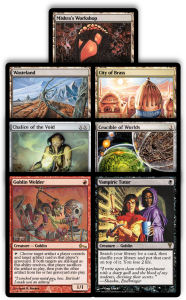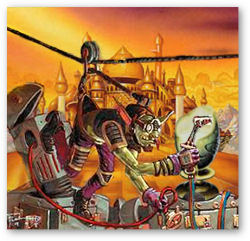And we’re back again! After nearly a three-month hiatus, I’ve finally remembered, "Hey, I said I was going to bring the best players opinions to the masses." So once again, I’ll be presenting scenarios and having various qualified players give their opinions on the best options in each case.
Today I’ll be presenting a Stax scenario with answers from Roland Chang, Jeremy Seroogy (The Spooky Kid), and Matt Ladwig (Hydra).
The Scenario
It’s game 1 and you’re on the play with Five-Color Stax against an unknown opponent.
Your opening seven-card hand is:

Mishra’s Workshop
Wasteland
City of Brass
Chalice of the Void
Crucible of Worlds
Goblin Welder
Vampiric Tutor
General tutor targets are standard Five-Color stuff: Ancestral Recall, Tinker, Balance, etc.
Question #1: What’s the play for turn 1?
Question #2: What’s your general plan going to be for the next few turns?
Question #3: Does the play change if you know your opponent has Force of Will in hand?
Thanks go to Jacob Orlove for coming up with the original scenario, though I tweaked it a wee bit.
Spooky Kid
I think the best set of turn 1 plays are laying City of Brass, going to 19, casting Goblin Welder, and then dropping Chalice of the Void at zero. If these two resolve, it guarantees your opponent is only going to be able to drop land and say go (barring any Sol Ring silliness). If he’s playing Stax, you’ve got a slight upper hand with the first Goblin Welder in play, and hopefully shutting off one or two cards in his hand. Meanwhile if he was playing a Drain deck, his options are limited to Brainstorm in most cases.
On turn 2, you’d cast Vampiric Tutor on upkeep: fetching Trinisphere, then playing Mishra’s Workshop and casting it. Even if Trinisphere was countered, it can easily be welded into play off the Chalice. The following turn I’d cast the Crucible of Worlds, because it would be impossible to have counter mana after that and I would continue to soft-lock the game up via Wasteland and other topdecks.
As for question 3, the Goblin Welder would work well as Force of Will bait regardless, so I wouldn’t change my play. Stax is topdeck dependant, so I’d simply hope I could draw a Smokestack or would cast Vamp for it shortly afterwards. The only scenario where this play wouldn’t be for the best would be against fast combo like Grim Long, where the better play would be to play Mishra’s Workshop and lay Chalice at one on my first turn, to prevent a quick Dark Ritual fueled kill. However, since we don’t know what we’re facing, this play is simply unfeasible.
Hydra
This hand is a good example of how Stax, more so than any other deck in the format, is opponent-dependent. This hand ranges from being very good against some decks (such as the mirror or against Gifts) to being merely average (against say Fish or Dragon). The only matchup where this hand is particularly weak is against a deck like Grim Long, where if the Grim Long player has a good hand or Draw 7 you’re pretty much done. Ichorid is also a tall order, as the Chalice doesn’t hurt them in the least. This is, however, a very good hand to have against a Drain player, as it gives you a variety of options.
The first turn with this hand pretty much plays itself against an unknown opponent: you play the City of Brass as your land for the turn, then cast Goblin Welder and follow it with Chalice of the Void set at zero. The Welder, assuming it resolves, makes the Vampiric Tutor very strong. It sets up a situation where you’re almost guaranteed to get whatever you tutor for into play. The Chalice allows you to slow down your opponent enough to get off your second and third turn plays.
At this point, the strategy that I would pursue would be casting the Vampiric Tutor during my upkeep for Trinisphere, then playing the Mishra’s Workshop as my land for the turn and casting the Trinisphere. If the Welder is still in play, it doesn’t matter whether or not the Trinisphere resolves, as you can easily bring it back with the Welder. This leads to a turn 3 play of playing out the Wasteland, as your land for the turn and playing the Crucible of Worlds.
The only time I would deviate from this strategy is if I was playing the mirror, in which case I would play out the Wasteland as my land for the turn and use the Vampiric Tutor to fetch a threat (probably Karn, as he would be the easiest to cast threat with the set-up the hand offers). I would then play out the Crucible on my third turn, playing out the Karn at the first opportunity while using Crucible/Waste/Chalice to keep my opponent as short as possible on permanents. Once he resolves, Karn plus Crucible should help end the game in a hurry.
If I know my opponent has the Force of Will, I would remain with the original gameplan presented, as Welder plus Trinisphere is very strong against the decks that would be playing Force of Will (the only real exception being the newer Dragon builds and some Fish decks, as a turn 1 Aether Vial is a major frown). A turn 1 Welder from a Control Slaver player can also be problematic, but Trinisphere/Wasteland/Chalice can help elevate the pressures that a turn 1 Welder would put on you.
Chang
#1) With that hand, my first turn play would be to first set the Chalice at zero, play the City of Brass, cast the Goblin Welder, and then pass the turn. To me, this would be the best play in that situation considering I have no knowledge of what my opponent is playing. The Chalice would hinder combo players, while a control player would hate to see a resolved Welder. Basically, I’m playing two powerful semi-lock pieces that allow me to set up for a second-turn lock in the combo or control match-up. One of the hardest things about Stax is establishing the correct lock. That is why I often prefer being on the draw and assessing my opponent’s first turn play to determine what he’s running.
#2) Based on what is played against me, I should be able to establish what I’m up against. This is where Five-Color Stax shines, since I can cast Vampiric Tutor during my upkeep and draw into the correct threat to follow up my first turn lock pieces. The flexibility seen here is the true strength of this archetype. Now, I’m going to briefly run through three commonly seen scenarios that require different plays depending on what your opponent lays down for his first turn. This is assuming that neither Chalice nor Welder was countered during your first turn.
Scenario #1: Your opponent lays down an Island, and then passes the turn.
I would assume almost immediately that I am up against a control deck. To prevent Drain mana from being available, the correct Vampiric Tutor target would be Strip Mine. This would send my opponent scrambling for more mana, and most likely respond with a Brainstorm to dig for it. If he does not have any more lands to throw down, then that is game. On my third turn, I would cast Crucible of Worlds with confidence and establish a Crucible-Strip lock.
Sidenote – If your opponent played a non-basic Blue-producing land and then passed the turn, the tutor should be getting Smokestack. During your turn, you would Waste away his land and on turn 3, play Smokestack for the win.
Scenario #2: Your opponent lays down a fetch-land, and then passes the turn.
This play puts me in a difficult situation, but there are a couple of ways to go about it. One option is to tutor up another Chalice of the Void, so I can set it at one during my turn. That play is okay, considering it prevents any further opposing Brainstorms, Welders, Gorilla Shamans, or even other artifact mana sources such as Mana Vault or Sol Ring. The downside is that it puts me into topdeck mode and I could stall out. Another option is to tutor for Bazaar of Baghdad during your upkeep. That way, I am getting better use out of my active Welder. It is crucial that I find a Smokestack, Strip Mine, or Sundering Titan to put pressure on his lands. Bazaar can do just that.
Scenario #3: Your opponent lays down Wasteland or Strip Mine and destroys your City of Brass.
Immediately, I would consider the possibility that I am up against the mirror. In that case, I would play the Mishra’s Workshop and play Crucible of Worlds on turn 2. That way I have taken the first action in a Crucible war. With Wasteland online next turn, the game could be over for him if he does not have Workshop, Crucible, during his second turn.
#3) The play would not change if I knew my opponent had Force of Will in hand. Of course, I could play mind tricks and lead with the Welder as bait. Generally against a control deck, I consider a Chalice set at zero pretty weak. The hand is only playable because of Vampiric Tutor. If it was not in the hand, I would have taken a mulligan that may produce a safer first turn play, such as a turn 1 Sphere of Resistance or Trinisphere.
General Conclusions

All three players had the same opening play of Chalice of the Void, City of Brass, and then casting Goblin Welder. The following turn, all of them chose to cast Vampiric Tutor on their upkeep, which is where the decision tree split off. Jeremy and Matt both chose the same play, which was to fetch Trinisphere and play that for an immediate soft-lock. Of course, with a Crucible of Worlds and Wasteland in hand, that soft-lock will soon become a hard one for the game win.
Meanwhile, Roland chose to find a different set of cards depending on which set-up his opponent laid on his first turn. Notably, in no situation did he choose to fetch out Trinisphere.
So who did you think was right? Chime in on the forums if you have an opinion you can express that’s longer than two sentences.
Joshua Silvestri
Team Reflection
Email me at: JoshDOTsilvestriATgmailDOTcom
